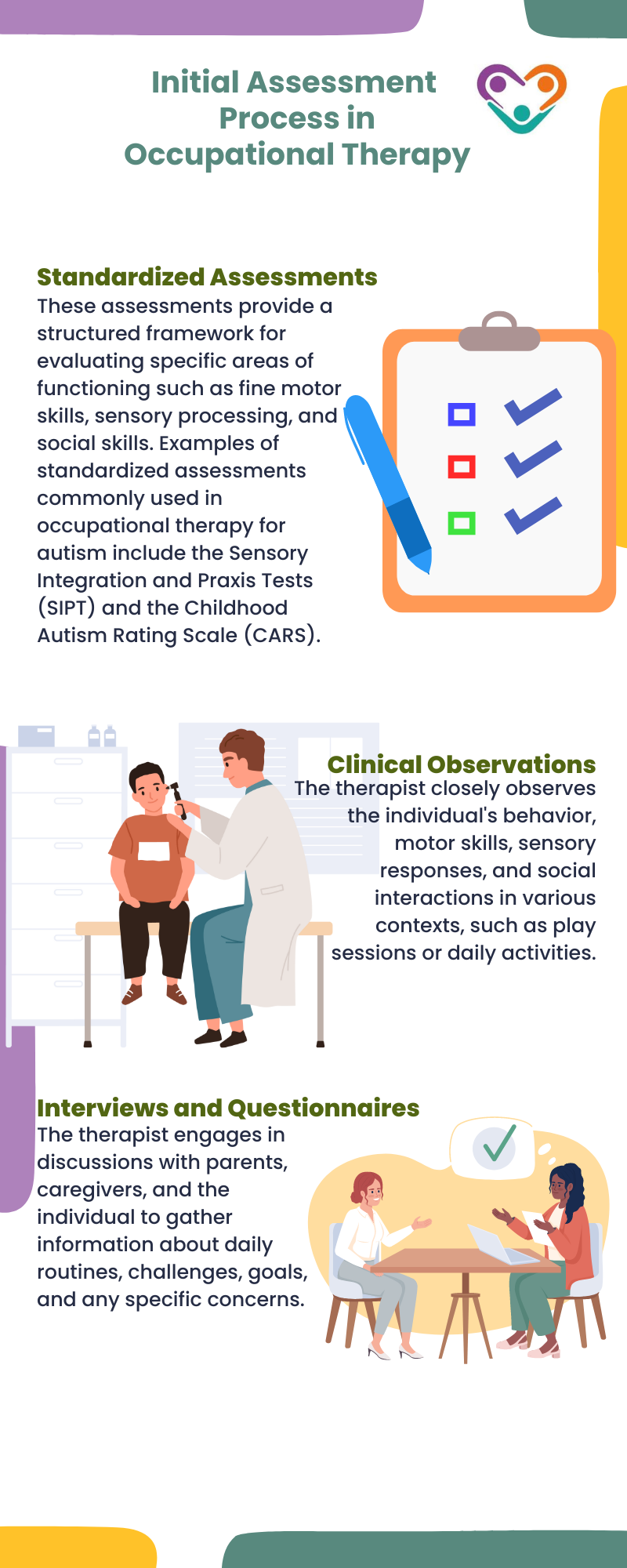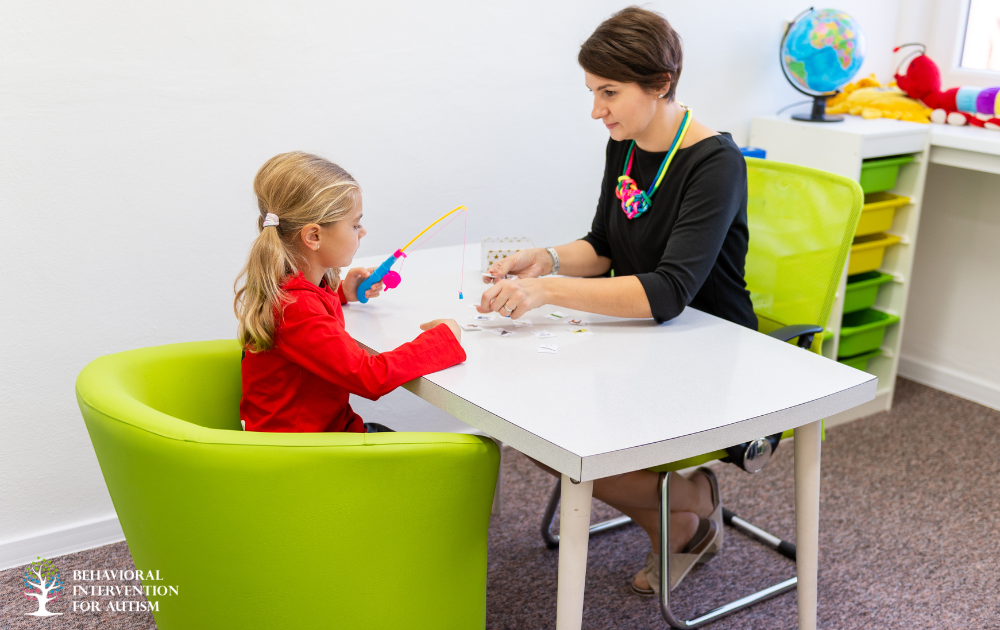
Table of Contents
Occupational therapy for autism focuses on helping individuals develop the necessary skills to engage in everyday activities and improve their overall quality of life. Occupational therapists work closely with individuals with autism to assess their current abilities and create personalized intervention plans.
The primary goal of occupational therapy is to enhance the individual’s participation in daily activities, such as self-care, play, and social interactions. Occupational therapists utilize evidence-based interventions and strategies to address specific areas of difficulty, such as sensory processing, motor skills, and self-regulation.
By implementing various therapeutic techniques and interventions, occupational therapists aim to improve the individual’s functional abilities and promote independence. They may also collaborate with other professionals, such as speech therapists and educators, to ensure comprehensive support for the individual with autism.
Benefits for Individuals with Autism
Occupational therapy for autism offers a range of benefits that can positively impact the lives of individuals with autism. Here are some of its key benefits:
- Improved sensory processing – Occupational therapy strategies can help individuals with autism better manage sensory issues, such as hypersensitivity or hyposensitivity, allowing them to engage more comfortably with their environment.
- Enhanced communication skills – Occupational therapists work on improving communication skills, including verbal and non-verbal communication. They may use various techniques, such as social stories or visual supports, to facilitate effective communication.
- Better motor skills – Occupational therapy interventions focus on improving fine motor skills, visual-motor coordination, and motor planning. These improvements can lead to increased independence in activities such as writing, dressing, and feeding.
- Increased adaptive behavior – Occupational therapy helps individuals with autism develop adaptive strategies to overcome challenges and succeed in daily activities. These strategies promote self-regulation, problem-solving, and flexibility.
- Improved overall well-being – By addressing specific challenges and providing individualized support, occupational therapy can enhance the overall well-being and quality of life of individuals with autism.
It’s important to note that the benefits of occupational therapy for autism can vary for each individual, as interventions are tailored to their unique needs and goals. Through the collaborative efforts of occupational therapists, individuals with autism can make significant progress in their abilities, empowering them to navigate daily life more effectively.
Occupational Therapy Evaluation
Before embarking on the journey of occupational therapy for autism, an initial evaluation process is conducted to assess the individual’s abilities, challenges, and specific needs. This evaluation serves as the foundation for developing personalized treatment plans aimed at promoting independence, self-regulation, and social participation.
Initial Assessment Process
The initial assessment in occupational therapy for autism involves a comprehensive evaluation of the individual’s developmental levels and functional capabilities. Occupational therapists utilize a variety of standardized assessments, clinical observations, and interviews with parents, caregivers, and the individual themselves to gather information.
During this assessment, the therapist reviews various areas including motor skills, sensory processing, emotional regulation, cognitive abilities, and interactions with caregivers and others.
The goal is to gain a comprehensive understanding of the individual’s strengths, challenges, and priorities.
The assessment process may include the following:
Personalized Treatment Plans
Based on the findings from the initial assessment, the occupational therapist develops a personalized treatment plan tailored to the individual’s unique needs. This plan outlines the goals, strategies, and interventions that will be implemented to address the identified areas of difficulty.
The treatment plan may include a combination of one-on-one therapy sessions, group therapy, home exercises, and parental or caregiver involvement. The therapist collaborates with the individual, family, and other professionals involved in the individual’s care to ensure a holistic and coordinated approach.
Throughout the therapy process, the occupational therapist continually monitors progress, adjusts the treatment plan as needed, and provides ongoing support and guidance. Regular re-evaluations are conducted to assess the effectiveness of the interventions and to make any necessary modifications.
By undergoing a thorough initial assessment and developing personalized treatment plans, occupational therapy aims to empower individuals with autism to enhance their overall functioning, promote independence, and improve their quality of life.
Occupational Therapy Interventions
Occupational therapy interventions for individuals with autism can play a vital role in supporting their development and enhancing their overall well-being.
Here are some of the most common interventions used in occupational therapy for autism:
Sensory Integration Therapy
Sensory integration therapy aims to help individuals with autism better process and respond to sensory information from their environment. Occupational therapists use various techniques and activities to address sensory challenges and promote sensory integration.
These interventions can help individuals with autism develop more appropriate responses to sensory stimuli, improve their sensory processing abilities, and enhance their overall sensory experiences.
Social Skills Training
Occupational therapy for autism places a strong emphasis on improving social skills and promoting meaningful social interactions. Through social skills training, individuals with autism are supported in developing their communication abilities, enhancing their understanding of social cues, and improving their overall social functioning.
Occupational therapists work closely with individuals with autism to help them navigate social situations, express themselves effectively, and establish and maintain meaningful relationships.
Cognitive-Behavioral Therapy
Cognitive-behavioral therapy (CBT) is another intervention commonly used in occupational therapy for autism. CBT focuses on addressing cognitive and behavioral challenges by helping individuals identify and modify negative thoughts, emotions, and behaviors.
Occupational therapists utilize techniques and strategies from CBT to support individuals with autism in managing anxiety, improving problem-solving skills, enhancing self-regulation, and developing coping mechanisms.
These occupational therapy interventions aim to address the unique needs and challenges faced by individuals with autism. By providing targeted support and interventions, occupational therapists help individuals with autism develop new skills, enhance their independence, and improve their overall quality of life
. It’s important to note that the specific interventions utilized may vary depending on the individual’s needs and goals, and a personalized treatment plan is created to address their specific requirements.
Occupational Therapy Techniques
Occupational therapy employs a variety of techniques to address the specific needs of individuals with autism. These techniques are designed to enhance their functional abilities and improve their overall quality of life.
In this section, we will explore three key occupational therapy techniques commonly used in the treatment of autism.
Play-Based Interventions
Play-based interventions are a fundamental component of occupational therapy for individuals with autism. These interventions focus on improving play skills, learning strategies, and self-care abilities.
Through play, occupational therapists can engage individuals with autism in purposeful activities that promote social interaction, communication, and motor skills development.
During play-based interventions, occupational therapists carefully assess the individual’s current level of ability and tailor interventions to meet their specific needs. By incorporating play into therapy sessions, individuals with autism can learn and practice new skills in a fun and engaging manner. Play-based interventions can also help manage sensory issues commonly experienced by individuals with autism.
Fine Motor Skills Development
Fine motor skills development is another crucial area addressed in occupational therapy for individuals with autism. Occupational therapists assess the individual’s motor skills, sensory processing, emotional regulation, cognitive abilities, and interactions with caregivers and others to determine the level of support needed.
Through various activities and exercises, occupational therapists work with individuals with autism to enhance their fine motor skills. These skills include tasks such as writing, dressing independently, engaging in school or work-related activities, meal preparation, and participating in the community.
By focusing on fine motor skills development, occupational therapy promotes increased independence, self-esteem, confidence, and overall functional ability.
Self-Care Strategies
Occupational therapy for individuals with autism also emphasizes the development of self-care strategies. This aspect of therapy aims to improve the individual’s ability to self-regulate emotions and participate in social interactions effectively. Occupational therapists evaluate the current developmental levels of children and adults with autism to identify areas of improvement.
By implementing self-care strategies, occupational therapists assist individuals with autism in developing essential skills necessary for daily activities. These skills may include effective communication, personal hygiene, grooming, managing personal belongings, and engaging in social situations.
Occupational therapy helps individuals with autism acquire the necessary tools to cope with sensory challenges and participate in daily activities with increased independence and confidence.
Through the utilization of play-based interventions, fine motor skills development, and self-care strategies, occupational therapy empowers individuals with autism to reach their full potential.
Collaboration in Occupational Therapy
Collaboration is a key aspect of occupational therapy for individuals with autism. The involvement of parents and caregivers, as well as a multi-professional approach, plays a vital role in maximizing the effectiveness of therapy and promoting the overall well-being of the individual.
Parents and caregivers are valuable partners in the occupational therapy journey for individuals with autism. They possess unique insights into the individual’s daily routines, challenges, and strengths.
Collaborating with parents and caregivers allows occupational therapists to gain a comprehensive understanding of the individual’s needs and helps tailor interventions accordingly.
By involving parents and caregivers, occupational therapists can provide guidance on strategies and techniques that can be incorporated into the individual’s daily life. This may include providing recommendations on creating a sensory-friendly environment, implementing visual schedules, or engaging in specific activities to support skill development. Through active participation, parents and caregivers can reinforce therapy goals and strategies outside of formal therapy sessions, promoting continuous progress.
Multi-Professional Approach
Occupational therapy for individuals with autism often involves a multi-professional approach. This approach emphasizes collaboration with various professionals involved in the individual’s care, such as speech therapists, physical therapists, educators, and psychologists. By working together, these professionals can address different aspects of the individual’s development and create a holistic treatment plan.
Collaboration among professionals allows for the exchange of knowledge, expertise, and insights from different disciplines. This interdisciplinary approach ensures that the individual’s needs are addressed comprehensively, considering the various domains of development affected by autism.
Through regular communication and coordinated efforts, professionals can align goals, strategies, and interventions to optimize outcomes for the individual.
Occupational therapists may also collaborate with educators to support the individual’s participation in school activities and promote the development of functional skills. This collaboration can involve sharing strategies for classroom accommodations, sensory integration techniques, and social skills interventions. By working closely with educators, occupational therapists can help create an environment that supports the individual’s learning and social engagement.
The involvement of parents, caregivers, and a multi-professional team in occupational therapy for individuals with autism ensures a comprehensive and collaborative approach to their care.
By combining the expertise and perspectives of these key stakeholders, occupational therapy can effectively address the individual’s unique needs, promote skill development, and enhance their overall quality of life.
Interested in how our services here at Behavioral Intervention for Autism in Florida can make a difference for you or your loved one? Reach out to us today to explore how we can help.
Sources:
https://www.autismspeaks.org/occupational-therapy
https://www.usa.edu/blog/occupational-therapy-for-autism
https://abilityactionaustralia.com.au/the-role-of-occupational-therapy-in-autism
https://www.easterntherapync.com/what-you-need-to-know-about-occupational-therapy-and-autism
https://www.trustedhealth.com/blog/occupational-therapy-autism
- 9 Common Obsessions of Children With Autism You Should Know - February 25, 2025
- What is Neurodiversity? A Guide to Embracing Differences - February 25, 2025
- Understanding Hyperfocus in Autism: What It Means and Why It Happens - February 25, 2025






